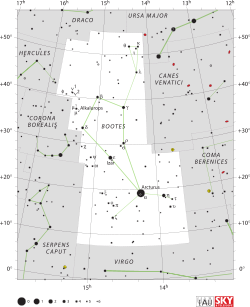Rho Boötis
| Observation data Epoch J2000 Equinox J2000 | |
|---|---|
| Constellation | Boötes |
| Right ascension | 14h 31m 49.78962s[1] |
| Declination | +30° 22′ 17.1781″[1] |
| Apparent magnitude (V) | 3.59[2] |
| Characteristics | |
| Spectral type | K4 III[3] |
| U−B color index | +1.44[2] |
| B−V color index | +1.30[2] |
| R−I color index | 0.65 |
| Astrometry | |
| Radial velocity (Rv) | −13.57±0.19[4] km/s |
| Proper motion (μ) | RA: –100.90[1] mas/yr Dec.: +120.73[1] mas/yr |
| Parallax (π) | 20.37 ± 0.18 mas[1] |
| Distance | 160 ± 1 ly (49.1 ± 0.4 pc) |
| Absolute magnitude (MV) | +0.27[3] |
| Details[5] | |
| Mass | 1.29±0.12 M☉ |
| Radius | 20.58±0.19 R☉ |
| Luminosity | 128.9±6.8 L☉ |
| Surface gravity (log g) | 1.85±0.05[6] cgs |
| Temperature | 4,285±54 K |
| Metallicity [Fe/H] | −0.19±0.10[6] dex |
| Age | 4.31±1.17 Gyr |
| Other designations | |
| Database references | |
| SIMBAD | data |


Rho Boötis, Latinised from ρ Boötis, is a single,[8] orange-hued star in the northern constellation of Boötes. It is visible to the naked eye with an apparent visual magnitude of 3.59.[2] Based upon parallax measurements, it is located at a distance of approximately 160 light-years (49 parsecs) from Earth. It is moving toward the Sun with a radial velocity of −13.6 km/s.[4] There is an optical companion, a magnitude 11.5 star, located 34.7 arcseconds away along a position angle of 345° (as of 2013).[9]
This is an evolved K-type giant star, currently on the red-giant branch, with a stellar classification of K4 III[3] and an estimated age of 4[5] billion years. Since 1943, the spectrum of this star has served as one of the stable anchor points by which other stars are classified.[10] It has around 1.23 times the mass of the Sun and has expanded to 20.6 times the Sun's girth. The star is radiating 129 times the Sun's luminosity from its enlarged photosphere at an effective temperature of about 4,285 K.[5] Rho Boötis is classified as a RS Canum Venaticorum variable.[11] Koen and Eyer examined the Hipparcos data for this star, and found that it varied with a period of 5.214 days, and an amplitude of 0.0027 magnitudes.[12]
Nomenclature
[edit]Rho Boötis is known by several different names, including ρ Boo, 25 Boötis, BD+31° 2628, FK5 534, HD 127665, HIP 71053, HR 5429, and SAO 64202.[13] In Chinese, 梗河 (Gěng Hé), meaning Celestial Lance, refers to an asterism consisting of ρ Boötis, ε Boötis and σ Boötis.[14] Consequently, the Chinese name for ρ Boötis itself is 梗河三 (Gěng Hé sān, English: the Third Star of Celestial Lance).[15]
References
[edit]- ^ a b c d e van Leeuwen, F. (November 2007), "Validation of the new Hipparcos reduction", Astronomy and Astrophysics, 474 (2): 653–664, arXiv:0708.1752, Bibcode:2007A&A...474..653V, doi:10.1051/0004-6361:20078357, S2CID 18759600.
- ^ a b c d Jennens, P. A.; Helfer, H. L. (September 1975), "A new photometric metal abundance and luminosity calibration for field G and K giants", Monthly Notices of the Royal Astronomical Society, 172 (3): 667–679, Bibcode:1975MNRAS.172..667J, doi:10.1093/mnras/172.3.667.
- ^ a b c Cardini, D. (January 2005), "Mg II chromospheric radiative loss rates in cool active and quiet stars", Astronomy and Astrophysics, 430: 303–311, arXiv:astro-ph/0409683, Bibcode:2005A&A...430..303C, doi:10.1051/0004-6361:20041440, S2CID 12136256.
- ^ a b Massarotti, Alessandro; et al. (January 2008), "Rotational and Radial Velocities for a Sample of 761 HIPPARCOS Giants and the Role of Binarity", The Astronomical Journal, 135 (1): 209–231, Bibcode:2008AJ....135..209M, doi:10.1088/0004-6256/135/1/209, S2CID 121883397.
- ^ a b c Baines, Ellyn K.; et al. (2018), "Fundamental Parameters of 87 Stars from the Navy Precision Optical Interferometer", The Astronomical Journal, 155 (1), 30, arXiv:1712.08109, Bibcode:2018AJ....155...30B, doi:10.3847/1538-3881/aa9d8b, S2CID 119427037.
- ^ a b Reffert, Sabine; et al. (2015), "Precise radial velocities of giant stars. VII. Occurrence rate of giant extrasolar planets as a function of mass and metallicity", Astronomy & Astrophysics, 574: A116, arXiv:1412.4634, Bibcode:2015A&A...574A.116R, doi:10.1051/0004-6361/201322360, hdl:10722/215277, S2CID 59334290.
- ^ "/ftp/cats/more/HIP/cdroms/cats", Centre de Données astronomiques de Strasbourg, Strasbourg astronomical Data Center, retrieved 15 October 2022.
- ^ Eggleton, P. P.; Tokovinin, A. A. (September 2008), "A catalogue of multiplicity among bright stellar systems", Monthly Notices of the Royal Astronomical Society, 389 (2): 869–879, arXiv:0806.2878, Bibcode:2008MNRAS.389..869E, doi:10.1111/j.1365-2966.2008.13596.x, S2CID 14878976.
- ^ Mason, Brian D.; et al. (2001), "The 2001 US Naval Observatory Double Star CD-ROM. I. The Washington Double Star Catalog", The Astronomical Journal, 122 (6): 3466–3471, Bibcode:2001AJ....122.3466M, doi:10.1086/323920.
- ^ Garrison, R. F. (December 1993), "Anchor Points for the MK System of Spectral Classification", Bulletin of the American Astronomical Society, 25: 1319, Bibcode:1993AAS...183.1710G, archived from the original on June 25, 2019, retrieved February 4, 2012.
- ^ "NSV 6697", The International Variable Star Index, AAVSO, retrieved 15 October 2022.
- ^ Koen, Chris; Eyer, Laurent (March 2002). "New periodic variables from the Hipparcos epoch photometry". Monthly Notices of the Royal Astronomical Society. 331 (1): 45–59. arXiv:astro-ph/0112194. Bibcode:2002MNRAS.331...45K. doi:10.1046/j.1365-8711.2002.05150.x.
- ^ "HD 127665". SIMBAD. Archived from the original on July 30, 2021. Retrieved August 9, 2021.
- ^ 陳久金 (2005), 中國星座神話 [Chinese Horoscope Myths] (in Chinese), 台灣書房出版有限公司, ISBN 978-986-7332-25-7.
- ^ AEEA 天文教育資訊網 2006年6月29日 [AEEA Astronomy Education Information Network June 29, 2006] (in Chinese), AEEA Astronomy Education Information Network, June 29, 2006, archived from the original on June 5, 2021, retrieved August 9, 2021.

